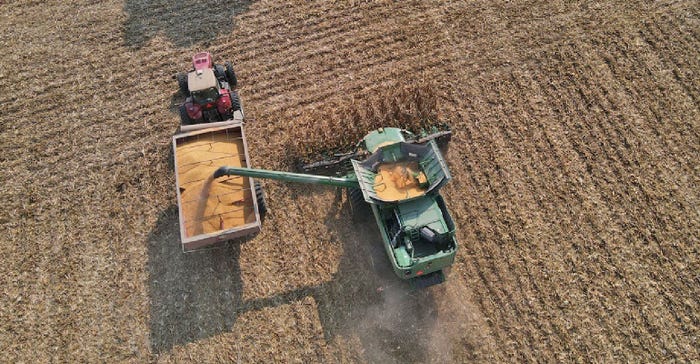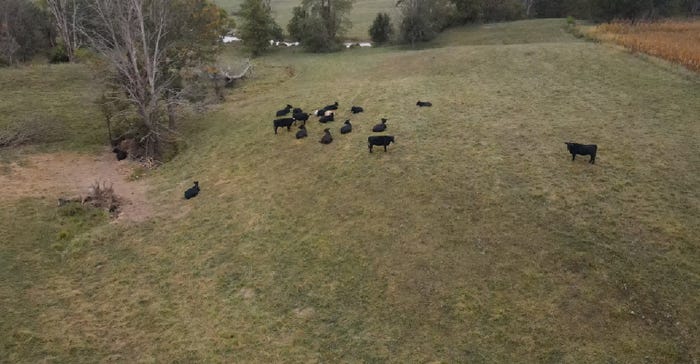December 9, 2020

Drones have become increasingly important within the agriculture industry, leading farmers to consider purchasing them to further the technological advances on each farm. But what are the benefits of having a drone as a piece of equipment on the farm?
I am the owner of the Mavic Air 2, a drone from the DJI line that was released in late April. Even though I have only owned it for a short time, the number of times I’ve been able to use it to assist on the family farm has been extremely beneficial.
Drones and crops
From what I’ve learned from being a drone owner myself, my family benefits because it makes scouting crops easier. Time and time again in 2020, I was called on to scout fields during the replant season. Scouting with a drone was beneficial in the sense of making replanting more efficient.
Drones now have the capability for farmers to buy software subscriptions that are compatible with their drones. This offers the ability to create maps that can provide crop information such as plant health and plant population. Such subscriptions can range anywhere from $30 to $250 per month. These apps allow services that provide the option to map your fields for a more productive scouting program.
During planting season, drones can be used to check for planting failures. Planting is one of the busiest seasons during the year, and drones make it easier to evaluate every field while allowing planting to happen at the same time. Drones can pinpoint problem areas at an earlier time.
On our farm, having a drone has made it a lot easier to scout fields and spot areas that the planter missed. I was able to communicate in real time with whichever family member was in the planter for replanting.
Drones can also help monitor damage to fields or farms after heavy weather systems move through. After large rain events, looking over densely covered, flooded fields from a higher line of sight can help when making decisions for field-drainage improvements.
Being able to fly a drone over any area of a farm that has sustained damage can help inform insurance adjusters where damage was sustained and helps prove it. This proved beneficial after a large storm system went through this past summer. I put my drone up and flew it around our property to find crop damage in the middle of the field rather than only discovering damage that could be seen from a road.

Drones and livestock
The drone’s ability to cover a lot of ground in a short period of time is useful for other common farm activities. Having many acres for cattle to roam means they often wander out of sight. The drone has allowed me to check cattle quickly while we’re in the middle of daily farm tasks.
Using the drone to monitor our livestock saves time because we don’t have to drive through multiple gates to get to the animals. The high camera quality associated with drones today, with new drones able to shoot up to 4K photo and video quality, sometimes features the ability to zoom in on objects, depending on what model you purchase.
These features allow you to distinguish individual animals to make sure each one is accounted for. With proper and technical flying maneuvers, you can even read the tags on each animal for distinction.

What I have found from experience is that drones make it easy to herd livestock as well. I would be lying if I said I hadn’t used my drone to bring goats up from the back of the pasture a few times. Driving them any direction is extremely easy with the drone.
Overall, while drones can be seen as pricey and an investment for a farmer, over time they’ve gained popularity and proved beneficial for farmers in everyday tasks. They help us save time and money.
What it takes to become an FAA-certified cowgirl!
In the U.S., the Federal Aviation Administration requires anyone who flies a drone that weighs 0.55 to 55 pounds to be certified as a remote pilot, whether they use it for commercial or educational purposes. This can include farmers because they use drones to make decisions on the farm or to work with beef cattle.
If a drone is within this weight class, it must be registered, regardless of how it will be used. Registration costs $5 and is available through the FAA website; it is good for three years.
A certification requires passing a written exam with 70% or more correct answers. The testing fee is $160, and the test must be performed at an official FAA testing facility. The exam includes topics about drone regulations, airport operations, the physics of flight, weather, physiological factors, risk assessment and radio communication procedures.
I found study guides through the FAA website to help study for this exam. Practice tests also help you know what kind of questions to expect. These were helpful for me to study because if I missed a question on the practice test, it would explain why the answer was wrong and why the correct answer was correct.
Once achieved, a remote pilot certification needs to be renewed every two years. For more information about drone regulations, visit faa.gov/uas.
Orme is a senior in agricultural communication at Purdue University. She is a part of her family farming operation in Rush County, Ind.
You May Also Like




